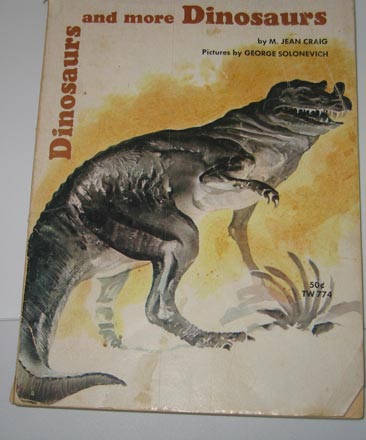Favourite, Fantastic Dinosaur Books (Part 1)
Children’s Books About Dinosaurs
Books have been written about dinosaurs and other prehistoric animals for more than one hundred and fifty years . As our knowledge regarding these long extinct creatures has grown so has the number of titles dedicated to the Dinosauria. The first publications were scientific papers distributed amongst the academic community describing new fossil finds and discoveries. However, the Victorian popular press in England featured many accounts of these fossil finds and explanations of new theories, spurred on by ground-breaking scientific works such as Sir Charles Darwin’s “Origin of Species” that was first published in 1859. This book was one of the first publications of its kind that set out to explain a theory relating to Earth sciences to the layman, it was not written specifically for the academic fraternity but to permit the general public to perceive and understand a new, scientific concept.
Favourite Dinosaur Books
Children’s books featuring dinosaurs followed much later, but with Natural History museums rapidly expanding to fit the new North American dinosaur discoveries into their exhibitions and with the public’s thirst to learn more about these giant reptiles, books both factual and fictional soon were becoming more plentiful. Sir Arthur Conan Doyle, the writer of the Sherlock Holmes stories, wrote a book entitled “The Lost World” – a story first published in 1912 about an expedition to a South American plateau where dinosaurs and other prehistoric animals were encountered. This book was first serialised in the popular “Strand” magazine before inspiring a stop-animation film in the late 1920s featuring a number of dinosaur species.
The number of children’s books dedicated to dinosaurs increased dramatically in the 1950s, coinciding with the general rise in popularity of science books and science fiction. A number of once very common publications are exceedingly rare and a good quality, first edition can fetch hundreds of pounds if sold at auction. The rise in the number of dinosaur illustrators allowed dinosaur books to feature a number of colourful illustrations, this work being pioneered by the likes of Charles Knight and the great Czech artist and illustrator Zdeněk Burian. It was in the 1950s that the dinosaurs had their first commercial boom, with a lot of toys, games and models being made. Dinosaur models were even given away in breakfast cereal packets, such as the much sought after plastic prehistoric animals from Nabisco of the United States. Dinosaur books too, in this period had a phenomenal growth with a number of publishing houses producing fact-based books specifically for the children’s market. Flicking through the pages of these books, invoke many childhood memories of reading about and discovering for the first time new dinosaurs and prehistoric animals. It is difficult to decide which ones would be a favourite, although it is hard to ignore the beautifully illustrated “Dinosaurs” – Watson and Zallinger published by Hamlyn or another later Hamlyn publication “Dinosaurs and Other Prehistoric Animals” – Leutscher that came a little later.
Reading Books About Dinosaurs
Reading books about dinosaurs which were published in different countries can provide a fascinating insight into how dinosaurs were viewed from different national perspectives. We are fortunate to have a number of Canadian and American dinosaur books in the collection, it is always a pleasure to read about dinosaurs such as Antrodemus, Brontosaurus and Trachodon – names of prehistoric animals that are no longer valid as taxons in scientific literature.
Recently, a colleague was given an old children’s book about dinosaurs. It is a book that none of us at Everything Dinosaur are familiar with. We suspect that it was first published in the United States, it has been fascinating to read it and to view all the illustrations of the prehistoric animals featured in it.
“Dinosaurs and More Dinosaurs”
Picture credit: Everything Dinosaur
Browsing through such books, shows how much our views regarding the Dinosauria have changed. Most of the early children’s books feature the long-necked dinosaurs (sauropods) depicting them as aquatic creatures living in swamps and lakes, where the water could support their great weight. This presumption about the behaviour of sauropods has largely been discounted by the scientific community. sauropods are seen as essentially terrestrial animals. However, recently an English science writer has re-ignited this debate by proposing that the majority of the dinosaurs did indeed live in water. A theory I first read about as a child in a book about dinosaurs has become prominent once again in academic circles.
For lots of educational, dinosaur themed toys, models and games: The Everything Dinosaur Website.


